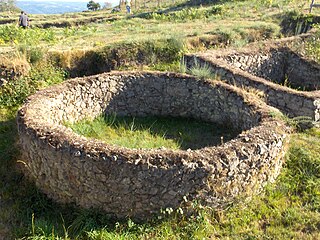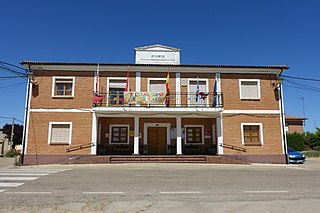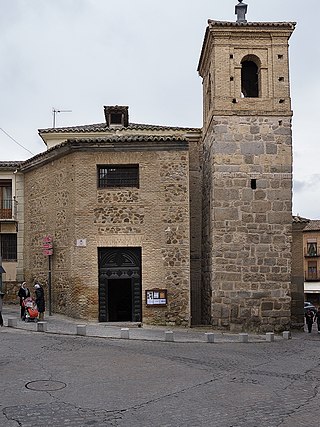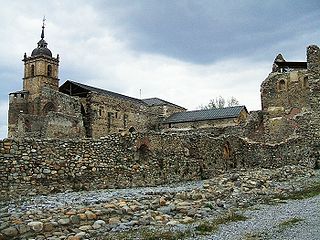
Celanova is a town and municipality located in the province of Ourense, Galicia, Northern Spain. Situated near the border with Portugal, the municipality is bordered by Ramirás, Cartelle, A Merca, A Bola, Verea and Quintela de Leirado.

San Miguel is a city in eastern El Salvador. It is the country's third most populous city. It is located 138 km (86 mi) east of the capital, San Salvador. It is also the capital of the department of San Miguel and a municipality. The population of the city in 2017 was 518,410.

Sensuntepeque is a town and municipality in the Cabañas department of El Salvador. It is the seat of the department and principal town in the area. Sensuntepeque is located about 83 kilometres (52 mi) northeast of the capital, San Salvador, at an altitude of 820 metres (2,690 ft).

Oteiza or Oteiza de la Solana, is a village and a Spanish municipality of the Foral Community of Navarra, located in the merindad of Estella, in the Estella Oriental region, 51 km from the capital of the community, Pamplona. Its population in 2016 was 939.

The Monastery of San Salvador of Leyre is a religious complex to the south of the Sierra of Leyre, in northern Navarre, Spain, representing one of the most important historical monasteries of Spain. The oldest records of the site date from 842, when Íñigo Arista, considered the first king of Pamplona, and Wilesindo, Bishop of Pamplona, made a donation to the monastery. The monastery grew in importance thereafter, acquiring numerous properties and wealth during the first and middle stages of the Kingdom of Navarre, thanks to the privileges and donations made by the Navarrese kings. The monastery was expanded in the twelfth century. Several kings of Navarre were buried there.
Samos is a municipality in the province of Lugo in Galicia, Spain. It contains the village of Samos.

Rairiz de Veiga is a municipality in Ourense in the Galicia region of north-west Spain. It is located in the centre of the province towards the south-west.

Husillos is a municipality located in the province of Palencia, Castile and León, Spain. According to the 2004 census (INE), the municipality had a population of 208 inhabitants.

Vega de Ruiponce is a municipality located in the province of Valladolid, Castile and León, Spain. According to the 2004 census (INE), the municipality has a population of 129 inhabitants. Its economy is mainly focused on the primary sector, specifically livestock and agriculture.

Saint Rudesind was a Galician bishop and abbot. He was also a regional administrator and military leader under his kinsmen, the Kings of León.

The Cathedral Basilica of Saint Antoninus is a Roman Catholic church located in Palencia, Spain. It is dedicated to Saint Antoninus of Pamiers.

According to Christian tradition, the Seven Apostolic Men were seven Christian clerics ordained in Rome by Saints Peter and Paul and sent to evangelize Spain. This group includes Torquatus, Caecilius, Ctesiphon, Euphrasius, Indaletius, Hesychius, and Secundius.

Saint Torquatus is venerated as the patron saint of Guadix, Spain. Tradition makes him a Christian missionary of the 1st century, during the Apostolic Age. He evangelized the town of Acci, identified as Guadix, and became its first bishop.

The Iglesia de El Salvador is a church in Toledo, Spain completed in 1159.

The Monastery of Saint Mary of Carracedo or the Monasterio de Santa María de Carracedo is an inactive abbey and palace complex, now in semi-restored state near the town of Carracedelo, province of León, Castile and León, Spain. Founded in the tenth century by the Benedictine order, it lies near the Way of Santiago in Northern Spain.

The Convent of San Francisco is located at the western end of Madero Street in the historic center of Mexico City, near the Torre Latinoamericana and is all that remains of the church and monastery complex. This complex was the headquarters of the first twelve Franciscan friars headed by Martín de Valencia who came to Mexico after receiving the first authorization from the Pope to evangelize in New Spain. In the early colonial period, this was one of the largest and most influential monasteries in Mexico City. It was built on the site of where Moctezuma II’s zoo once was. At its peak, the church and monastery covered the blocks now bordered by Bolivar, Madero, Eje Central and Venustiano Carranza Streets, for a total area of 32,224 square metres.

Sobrado Abbey, is a Cistercian monastery in the province of La Coruña, Galicia, Spain. It is situated in the municipality of Sobrado, about 9 km east of Corredoiras and about 46 km southeast of Betanzos, at an altitude of 540 m above sea level.

The Abbey of San Pedro el Viejo is a former Benedictine monastery in the old town of Huesca, Aragon, Spain.

The Monastery of San Salvador was a Benedictine monastery in the town of Oña, in the province of Burgos, central Spain, founded in 1011, which lasted until the 19th century.

The Church of San Antón is a Catholic church located in the Old Town neighbourhood of Bilbao, Spain. It is dedicated to Anthony the Great, known as San Antón in Spanish. It is featured, along with the San Antón Bridge, in the city's coat of arms. The estuary of Bilbao flows next to it.



















